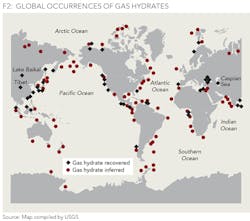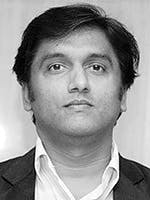India's gas hydrates
COMMERCIAL PRODUCTION IS STILL A DECADE AWAY, BUT NGH ARE A POTENTIAL GAME-CHANGER FOR INDIA
MANISH VAID, OBSERVER RESEARCH FOUNDATION, NEW DELHI
THE UNITED STATES GEOLOGICAL SURVEY (USGS), which is involved in natural gas hydrate (NGH) research in India and Japan, has assisted the Indian Oil Ministry in discovering highly enriched accumulations of NGH in the Bay of Bengal. This discovery is the first of its kind with a potentially producible large accumulation of gas hydrates in the Krishna Godavari Basin, off India's east coast.
Hydrate Energy International (HEI) has estimated India's NGH resource potential at 933 trillion cubic feet, which could represent a global energy game changer, provided the technologies for gas production from hydrate reservoirs are established techno-economically.
While research and development organizations around the world are defining and developing multiple techniques to explore and exploit natural gas hydrates, the Indian government is mulling production testing for some of these reserves.
The biggest incentive behind accelerating research and development of NGH is its abundance, which surpasses all other global fossil fuels combined. Therefore, this resource could become an energy game-changer for the world, solving the energy woes of a number of countries, such as India, which currently must import a high percentage of their fuel supplies.
The second biggest motivation for developing NGH is that they are widely distributed in marine surroundings, where 99% of global inventory is located. The remaining 1% is present in the permafrost in Arctic regions.
India would do well to develop its own NGH reservoirs and fast-track its NGH program to deal with its increasing energy demand, uncertainty of its supplies, and urgent need to reduce greenhouse gases (GHG). However, like other countries, India, too, is in a nascent stage of developing its NGH resources, in part due to economic and technical challenges.
WHAT ARE NATURAL GAS HYDRATES?
The term NGH is used interchangeably with "methane hydrate," "gas hydrate," and "clathrate." These are solid ice-like combinations of water and methane formed naturally under the conditions of high pressure and low temperature, known as the Gas Hydrate Stability Zone (GHSZ). In addition to such conditions, the presence of organic carbon can ensure the availability of NGH in the region. It is estimated that gas hydrates account for about one-third of the world's mobile organic carbon.
Natural gas hydrates are formed in two main regions, the Arctic and in the ocean (see Figure 1). In the Arctic, NGH are formed where cold air temperatures create thick zones of permanently frozen soils, or permafrost, at a depth of about 300 to 400 meters (1,000 to 1,300 feet) below the land surface.
In the case of an ocean or deep inland lakes, when methane and water combine at high pressure and low temperature generated by 300 to 500 meters (1,000 to 1,600 feet) or more of overlying water, NGH are formed. However, in both the cases, the high concentration of the deposits as well as its safe recovery plays an important role in NGH occurrences. Further, in a marine environment, NGH exist in deep water, shallow water depths, and even in warmer sea-bottom temperatures, depending on the precise chemical composition.
In the Gulf of Mexico, for instance, NGH have been found at shallow water depths and high temperature waters of 20 degrees centigrade (68 degrees Fahrenheit). This can happen due to the presence of ethane in the gas mixture, providing more stability and making the existence possible in warmer waters with lower pressures. Thus, a gas mixture that contains just 10% ethane makes an NGH stable at 6 atmospheres (atm) with 60 meters (200 feet) of water column. This contrasts with 100% methane hydrates, which are stable only at pressures exceeding approximately 40 atmospheres with a 400-meter (1,300-foot) water column.
NGH have not been extensively studied due in part to their occurrence in relatively inaccessible polar and marine environments. It wasn't until the 1970s when the existence of NGH was confirmed by industry drilling in Arctic permafrost. Marine NGH were confirmed in the 1980s during scientific expeditions, including that of the Deep-Sea Drilling Program's R/V Glomar Challenger. Figure 2 shows various locations at which NGH have been recovered and or confirmed to date.
According to Arthur H. Johnson of HEI, US, the global resource potential of gas hydrates is vast, indicating 43,300 trillion cubic feet of reserves, of which about 50% is expected to be technically recoverable.
FROM PROBLEM TO POTENTIAL
NGH are volatile compounds that are stable in the extreme cold and tremendous weight of deep water. However, when natural gas hydrates are built up inside the drill column of a well, they become extremely dangerous. Destabilized heat and lower pressure can prompt NGH to expand quickly to 164 times their volume leading to an explosion, as occurred with BP's Deepwater Horizon rig in the Gulf of Mexico rig on April 20, 2010. This resulted in loss of life and an estimated three million gallons of crude oil pouring into the Gulf and endangering the marine ecosystem. NGH have long been regarded as a drilling hazard, going back to the 1930s, when the hydrates formed blockages in oil and gas pipelines.
But growing energy demand, climate concerns, and a desire to shift towards cleaner fossil fuels have changed the interpretation of NGH as a potential energy resource of the future. However, producing NGH and effectively converting them to energy in an environmentally safe manner remain a significant challenge.
In this regard, technology will have to play bigger role in tapping into this potentially huge energy resource. Just as technology helped create a shale boom in the United States, it will have to do so to enable the exploitation of gas hydrates. NGH are found mainly in difficult terrains such as in deep and ultra-deep waters and in the Arctic, so new technologies will prove crucial in their development.
However, the considerable rewards of releasing methane from the NGH fields must be balanced with risks. This warrants more stringent efforts towards mitigating the inherent risks associated with developing NGH. The challenge therefore, also pertains with respect to uncontrolled release of methane from hydrate formations into the atmosphere, which could result in leakage and make NGH extraction inefficient and uneconomical. According to the report, titled, "Frozen Heat: A Global Outlook on Methane Gas Hydrates" published by the United Nations Environment Program in 2014, gas hydrate dissociation might amplify future warming, ocean acidification, and oxygen loss.
However, recent studies also suggest that circulation of cold seafloor water near exploration or production activities is sufficient to dramatically reduce the risk of NGH-induced sediment instability, besides the usage of other refrigeration techniques. This significantly reduces the environmental risk character of the NGH resources.
Bringing down the cost of producing natural gas from NGH fields is yet another challenge. At the nascent state of current technologies and level of expertise available, extracting gas hydrates is a very costly affair, making its commercial production unlikely for the next 10 to 15 years, barring a quick technological breakthrough.
Darren Spalding and Laura Fox of Bracewell in London, in an article titled, "Challenges of Methane Hydrates" published in the May 2014 issue of Oil and Gas Financial Journal, estimated the cost of producing gas from methane hydrates in the range of US$30 to US$50 per million British thermal units (MMBTUs). This enormous cost, according to the International Energy Agency (IEA), can be brought down significantly between US$4.70 and US$8.7 per MMBTU once efficient practices and processes are developed.
After realizing the resource potential of NGH, the world is now evolving fast from viewing this energy source as a problem to developing ways to manage the same. This can support the global efforts in shifting towards cleaner fossil fuel in a big way as an alternate fuel to oil and coal, thereby reducing emissions from GHG significantly.
Given the poor energy endowments of major importing countries such as Japan, India, and South Korea and the need to shift towards cleaner fossil fuels such as natural gas, several countries have initiated NGH programs. The US Department of Energy (DOE) has so far played a leading role in NGH research, followed by Japan, which initiated a research program in the mid-1990s.
However, NGH research is still at the research stage with no commercial production so far established anywhere in the world. In this regard, several production research and development studies have been carried out at places such as the Mallik site in Canada's Mackenzie Delta and the Nankai Trough off the southern coast of Japan, under their respective programs.
In the United States, the NGH program is operated by the DOE, whose major focus has been the Gulf of Mexico. In addition, the DOE, along with the USGS and Japan, are working to evaluate potential drilling locations and develop viable project structures.
GAS HYDRATE PROGRAMS IN INDIA
In India, gas hydrate programs were initiated in 1996 by the Gas Authority of India Limited (GAIL) under the auspices of the Ministry of Petroleum & Natural Gas (MoPNG). Built on the results of the US Department of Energy's first national NGH program of 1982, the National Gas Hydrate Program (NGHP) was restructured under the Directorate General of Hydrocarbons (DGH).
National upstream companies such as Oil and Natural Gas Corporation Limited, GAIL, Indian Oil Corporation Limited and Oil India Limited, and national research institutions such as the National Institute of Oceanography (NIO), the National Geophysical Research Institute (NGRI), and the National Institute of Ocean Technology (NIOT) were entrusted to reanalyze the resource potential of NGH along the Indian shelf followed by technology development for safe production of gas from NGH.
Further, MoPNG and DGH have signed MoUs with agencies such as the USGS, the US-DOE (under renewal), the US-Minerals Management Services (now Bureau of Ocean Energy Management) (under renewal), Japan Oil, Gas and Metals National Corporation (JOGMEC), GFZ-POTSDAM, Germany and IFM-GEOMAR, Germany.
NGHP carried out its Expedition-01 in 2006 in which the presence of significant quantities of NGH has been established in the Krishna Godavari (KG), Mahanadi, and Andaman basins. Under this expedition no assessment has been made on the potential of gas hydrates in this region. However, Hydrate Energy International has estimated the NGH potential in India at 933 TCF.
Under this phase, 21 sites were drilled in four areas – the Kerala-Konkan Basin, west coast; the Krishna-Godavari Basin, east coast; the Mahanadi Basin, east coast; and the Andaman Sea (see Figure 3).
The Expedition-02, approved by the Steering Committee in 2015, has been tasked to identify sites which would ideally have (1) sand dominated gas hydrates occurrence, (2) reasonably compacted sediments and (3) occurrence of free gas below the gas hydrate stability zone. Under this expedition, drilling and coring operations were carried out by a state-of-the-art Japanese vessel, called Chikyu, hired for exploring for gas hydrates in the KG basin, which drilled 40 wells.
The Steering Committee has also approved the fund sharing of the expenditure of NGHP Expedition-02. Based on the results of this phase, further surveys and geo-scientific studies will be planned to identify suitable locations for carrying out pilot production testing in NGHP Expedition-03.
Earlier, under the Ministry of Earth Sciences (MoES), a comprehensive research-oriented gas hydrates program was launched emphasizing the scientific and technological development with objectives like, understanding the nature of distribution of gas hydrates in marine sediments; developing techniques for detection and quantification of gas hydrates; identifying promising sites on regional scale and estimating the resource potential and monitoring environmental perturbation during harvesting of gas hydrates. During the previous financial year 2015-16, the Government of India allocated Rs. 1179 crore to the MoES for Oceanography Research and Meteorology, including research on NGH.
CONCLUSION
In his speech at Petrotech-2016, Indian Prime Minister Narendra Modi once again emphasized the need to increase India's domestic oil and gas production and to reduce import dependence while striving towards a gas-based economy. The accelerated NGH program of India is a step forward in this direction. As with the technological developments that helped launch the shale boom in the US and saw rapid expansion in the span of a single decade, global NGH research and production could follow suit.
Notably, unlike above the ground complexities of shale production, NGH deposits have physical properties and reservoir settings that appear conducive to production using conventional hydrocarbon recovery methods. Thus, production testing of NGH may lead to direct supply of gas the existing infrastructure in place. However, the evaluation of future NGH will certainly depend on social, economic, environmental, and political considerations, besides addressing scientific and technical bottlenecks, particularly with regard to its environmentally safe extraction and transportation to the existing natural gas infrastructure and markets.
For the immediate future, it is important that the government continues to push harder for NGH research through sufficient funding and active participation of the hydrocarbon industry. Given certain constraints, commercial production is still at least a decade away. This allows India concurrently to augment its other non-conventional energy sources, such as shale gas and coal-bed methane (CBM) in addition to conventional domestic energy sources in its pursuit of energy security goals.
ABOUT THE AUTHOR
Manish Vaid is a junior fellow with the Observer Research Foundation in New Delhi. His research interests include energy policy and geopolitics.
The views expressed in the article are that of the author.





